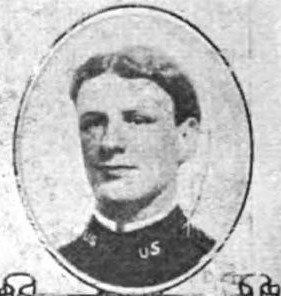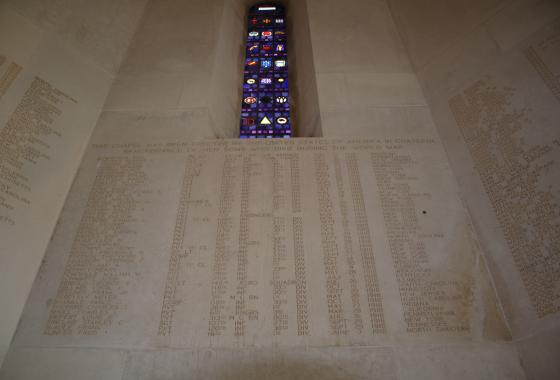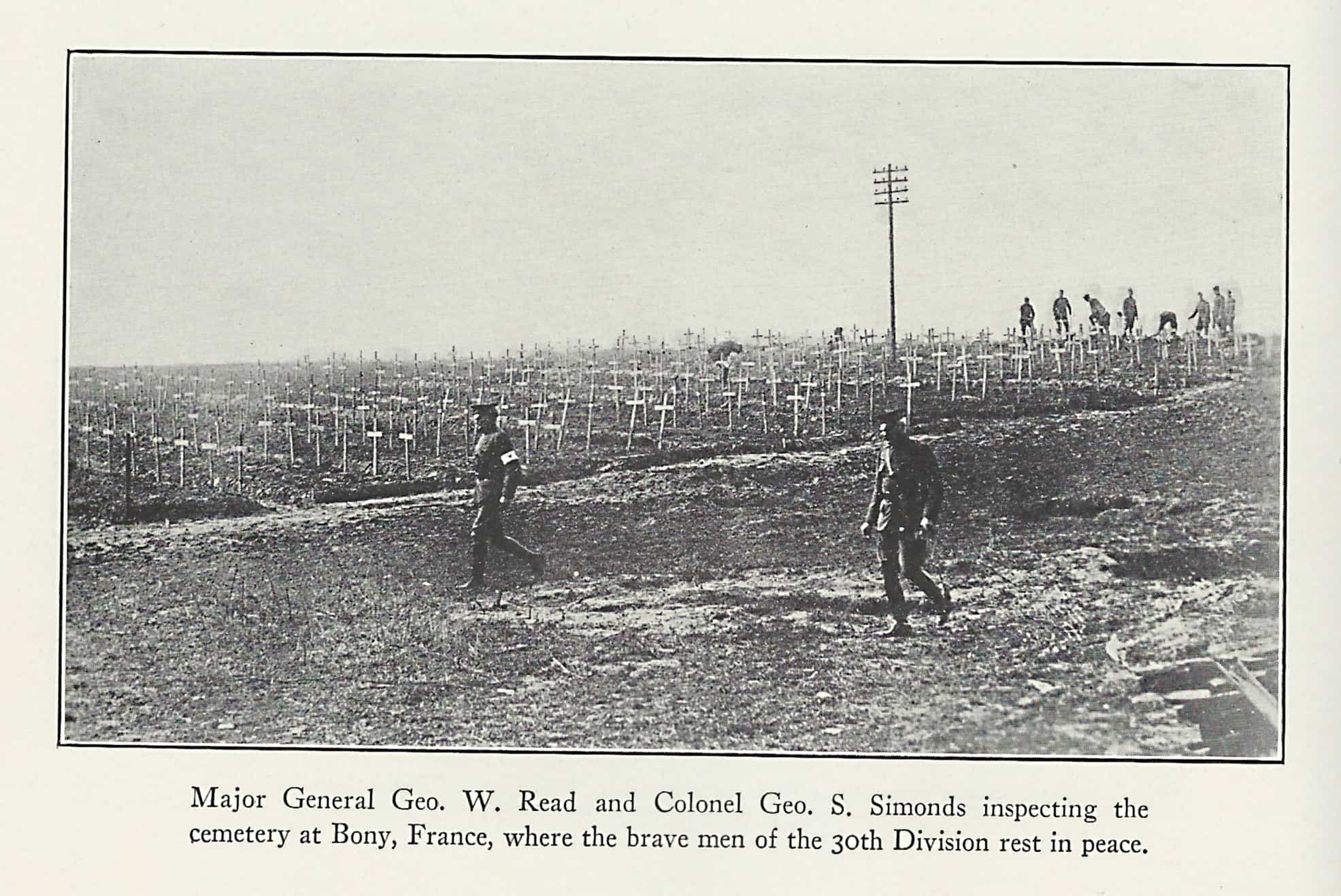First Lieutenant William Augustus Hudgens

- Unit: 30th Division, 59th Infantry Brigade, 3rd Infantry Battalion, 118th Infantry Regiment
- Date of Birth: August 26, 1878
- Entered the Military: March 12, 1917
- Date of Death: September 8, 1918
- Hometown: Honea Path, South Carolina
- Place of Death: near Bellicourt, France
- Cemetery: Tablets of the Missing, Somme American Cemetery, Bony, France
Blythewood High School
2018-2019
Early Life
On September 26, 1878, William Augustus Hudgens was born. He was the fifth of nine children born to parents Thomas and Ella Hudgens. His family lived in Honea Path, located in Anderson County, South Carolina.
Hudgens married Lucia Taylor on June 19, 1901. Together, they had six children. Three died at an early age. The other three survived their father’s death in World War I. He served as an officer in the South Carolina National Guard.

Soldiers from the 118th Infantry Regiment, Company K, building roads at Camp Sevier, South Caroline, c. 1917. Courtesy of the Greenville Journal.

Loading and firing drills, 118th Infantry Regiment, Company L at Camp Sevier, South Caroline, c. 1917. Courtesy of the Greenville Journal.

In front of the mess hall, Camp Sevier, South Carolina, March 1919. National Archives and Records Administration (165-WW-529A-005-ac).
Military Experience
As a lieutenant with the U.S. Army’s 30th Division, Hudgens served with men from North Carolina, South Carolina, and Tennessee National Guard units. On April 12, 1917, just ten days after the United States declared war, Hudgens’ unit was called into service. Initially organized at Camp Sevier, South Carolina in August 1917, the 30th Division gained full operating strength in October, with the addition of selective service men from training camps in Arkansas, Georgia, and South Carolina.
Hudgens and his men trained at Camp Sevier until May 1918. The U.S. Army then dispersed the troops to camps in New York and New Jersey. On May 11, the men boarded the Gloucesteshire from Brooklyn, New York and departed for Great Britain.
After a brief rest in camps in England, the 30th Division proceeded to Calais and Le Havre, France. The British Second Army began training the troops and the 30th Division remained under British command for the remainder of the war. After several weeks, the American and British troops moved to Poperinge, Belgium. Just ten kilometers outside of Ypres, both armies assisted in the defense of the East Poperinge Line.
On July 16, 1918, the British Second Army ordered the 30th Division to move south of Ypres, Belgium and occupy portions of the front line in the Canal Sector. From here, the 30th Division took an active role in the Ypres – Lys Offensive, which started on August 19 and continued into September. The division achieved its objective by increasing the advance of the line by September 2. The troops took control over Moated Grange, Vormezeele, and Lankhof Farm in the process. The British 35th Division relieved the men of their control of the line. They moved to Saint-Pol-sur-Ternoise, 50 kilometers north of Amiens, France. There the 30th Division joined forces with the British I Corps.
Due to the growing numbers of American troops, German defenses weakened. The Allied Powers gained a tactical advantage in the summer and fall of 1918. To follow up on their success in the fighting near Ypres, the American First Army sent the 30th Division to a position near Bellicourt, France. There, the unit took part in the Somme Offensive, which launched on September 29, with the intent to penetrate the German defensive positions along the Hindenburg Line. The Australian 1st Division and the American 30th Division successfully captured Bellicourt on September 29. Their advance continued until October 11-12 when the U.S. 27th Division relieved the troops.
During the Somme Offensive, Hudgens engaged in the fighting and died in battle on October 8, 1918. The Anderson Daily Mail reported that Hudgens died instantly after being struck by shrapnel from an artillery shell. His remains were not recovered.

King George of England and Major General Lewis inspecting troops of the 30th Division in the area of Poperinghe, Belgium, August 6, 1918. Courtesy of the Greenville Journal.

115th Machine Gun Battalion, Company B, operating a machine gun in Ribeauville, France, October 18, 1918. Courtesy of the Greenville Journal.
Eulogy
Hudgens’ death came as a shock to his family and many friends in Anderson County and the Piedmont region. The Greenville News published notification of his death in their paper on November 6, 1918 and included the following statement, “The many friends in this city and his family will certainly learn with great sorrow of his death.” He left behind his wife and three children.
In 1931, Hudgens’ widow, Lucia Taylor, traveled to France as part of the Gold Star families trips that were sponsored by the U.S. government. During this trip she was able to pay her final respects to her husband at the Somme American Cemetery in Bony, France where William Augustus Hudgens’ name is memorialized on the Tablets of the Missing.

Walls of the Missing at Somme American Cemetery in Bony, France. American Battle Monuments Commission.

Major General George W. Read and Colonel George S. Simonds inspecting the temporary cemetery at Bony, France. Courtesy of the Greenville Journal.

William Hudgens’ headstone at Honea Path Presbyterian Church Cemetery in Honea Path, South Carolina, April 2013. Find a Grave.
Reflection
Bibliography
30th Division; Records of Combat Divisions, 1918-1919, Records of the American Expeditionary Forces (World War I), Record Group 120 (Box 15); National Archives at College Park, College Park, MD.
30th Division; Records of Combat Divisions, 1918-1919, Records of the American Expeditionary Forces (World War I), Record Group 120 (Box 86); National Archives at College Park, College Park, MD.
30th Division; Records of Combat Divisions, 1918-1919, Records of the American Expeditionary Forces (World War I), Record Group 120 (Box 88); National Archives at College Park, College Park, MD.
“100 Years Later, the Great War’s Impact on Greenville Remains Evident.” January 18, 2018. Accessed February 26, 2019. greenvillejournal.com/2018/01/18/100-years-later-great-wars-impact-greenville-remains-evident/.
118th – 120th Infantry Regiments; World War I Strength Returns, Records of the Adjutant General’s Office, Record Group 407 (Box 51); National Archives at College Park, College Park, MD.
American Battle Monuments Commission. 30th Division: Summary of Operations in the World War. Washington, DC: U.S. Government Printing Office, 1944. babel.hathitrust.org/cgi/pt?id=uc1.b3110102&view=1up&seq=3.
“Capt W.A. Hudgens Killed in Action.” Greenville News. November 6, 1918.
Doyle, A. C., Haulsee, W .M., and Howe, F.G. Soldiers of the Great War. Washington, DC: Soldiers Records Publishing Association, 1920.
In front of the mess halls, Camp Servier, Greenville, S.C. Photograph. March 1919. National Archives and Records Administration (165-WW-529A-005-ac). Image.
South Carolina. Anderson County. 1900 U.S. Census. Digital Images. ancestry.com.
War Diaries (30th Division); A. E. F. General Headquarters, Records of the American Expeditionary Forces (World War I), Record Group 120 (Box 2723); National Archives at College Park, College Park, MD.
“William A. Hudgens.” American Battle Monuments Commission. Accessed August 19, 2019. abmc.gov/node/347348.
William A. Hudgens. U.S. Headstone Applications for Military Veterans, 1925-1963. Digital Images. ancestry.com.
“William Augustus Hudgens.” Find A Grave. Updated June 14, 2010. Accessed February 27, 2019. www.findagrave.com/memorial/53691346.
William Augustus Hudgens World War I Burial Case File; Correspondence, Reports, Telegrams, Applications and Other Papers relating to Burials of Service Personnel, Records of the Quartermaster General’s Office, 1915-1935, Record Group 92; National Archives and Records Administration – St. Louis.
“WWI.” 30th Infantry Division. Accessed February 27, 2019. 30thinfantrydivision.weebly.com/wwi.html.

